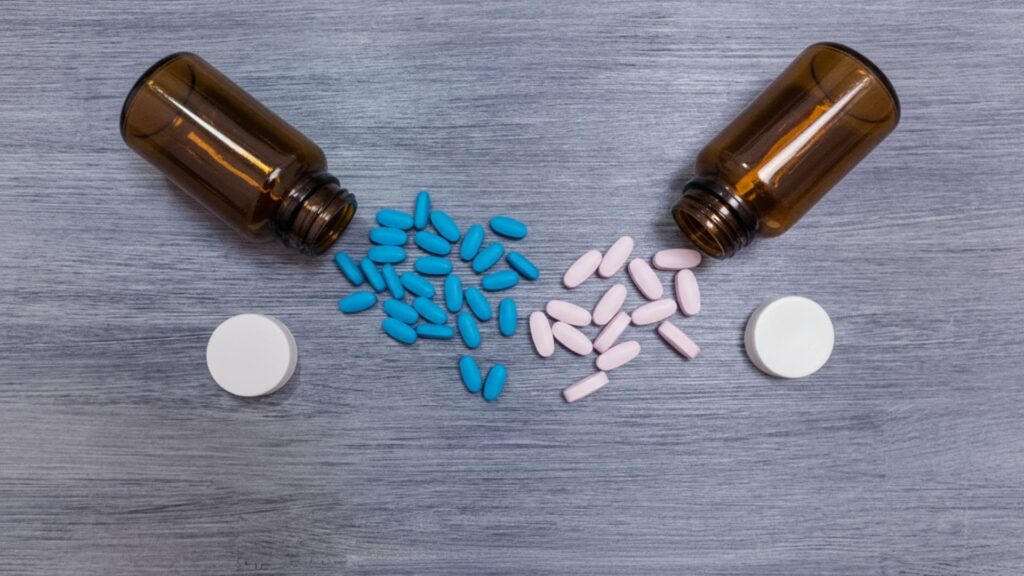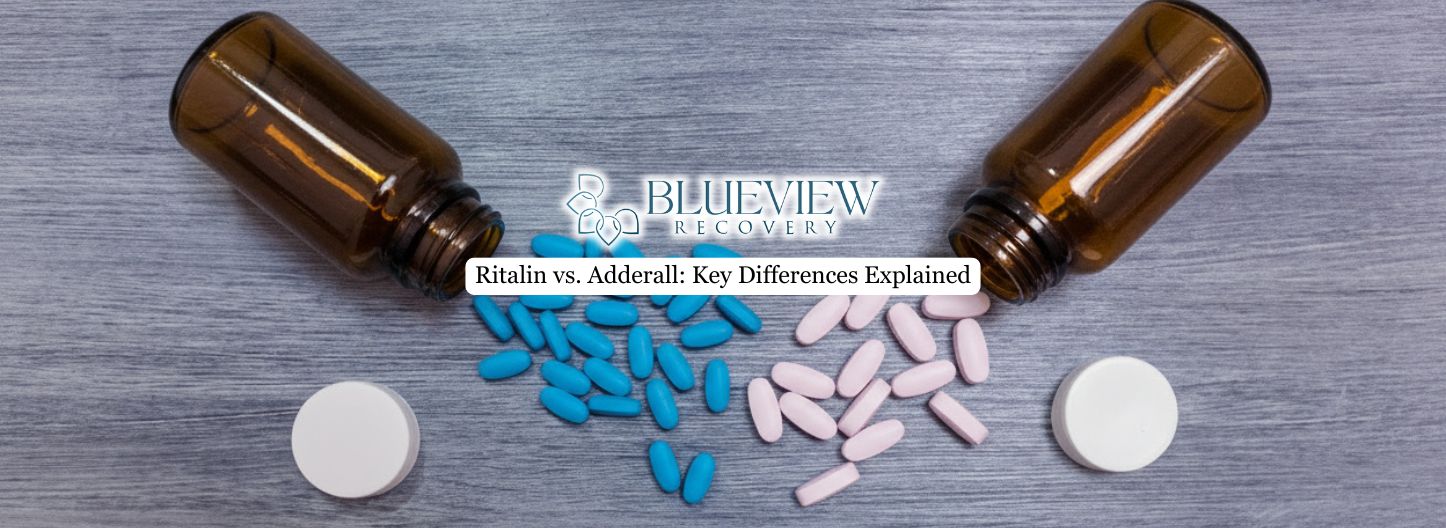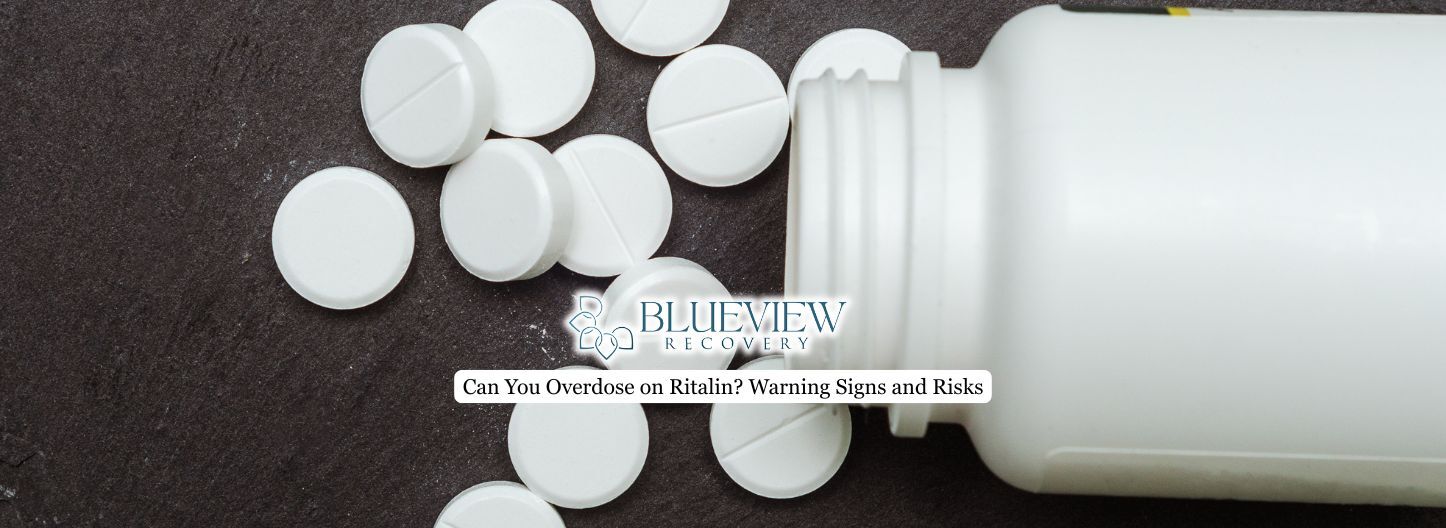Ritalin and Adderall are two of the most commonly prescribed medications for attention-deficit hyperactivity disorder (ADHD) and narcolepsy, characterized by difficulty maintaining attention and excessive daytime sleepiness, respectively. Both drugs help manage symptoms such as inattention, hyperactivity, and impulsiveness, yet they differ significantly in their chemical makeup and effects.
In this article, the key differences between the two will be explained, covering their mechanisms, uses, side effects, and more.

Drug Composition and Categorization
Ritalin and Adderall are central nervous system stimulants used primarily to treat attention-deficit hyperactivity disorder (ADHD) and, in some cases, narcolepsy.
Ritalin contains methylphenidate, a stimulant chemically classified as a piperidine derivative. It works by increasing dopamine and norepinephrine activity in the brain, helping to improve focus and impulse control.
Adderall, by contrast, is composed of a mixture of amphetamine salts, specifically dextroamphetamine and levoamphetamine, which enhance similar neurotransmitters but through slightly different mechanisms.
While medications belong to the same therapeutic class, their chemical structures and pharmacological profiles lead to subtle differences in onset, duration, and individual response.
How They Work: Mechanism of Action
Ritalin primarily works by blocking the reuptake of dopamine and norepinephrine, which means it prevents these neurotransmitters from being taken back into neurons too quickly. This increases their concentration in the brain synapses, enhancing communication between nerve cells and improving focus and alertness. It tends to act faster but for a shorter period, making it suitable for situations where quick but brief symptom relief is needed.
In contrast, Adderall not only inhibits the reuptake but also increases the release of dopamine and norepinephrine from nerve endings. This dual action causes a stronger increase in these neurotransmitter levels, which often results in a more potent stimulant effect. Because of this, it tends to have a longer onset and duration of activity in the brain. The drug’s mechanism supports a longer-lasting effect, often preferred by people requiring consistent symptom control throughout the day.
These differences affect how quickly each starts working and how long their actions last. Understanding these mechanisms helps explain why patient responses can vary between the two.
Medical Indications, Effectiveness, and Duration
They are primarily prescribed for ADHD and narcolepsy. While their core medical indications overlap significantly, doctors may prefer one over the other based on individual patient response, side effect tolerability, or specific symptom presentation. Occasionally, off-label uses such as treatment for depression or cognitive enhancement are seen, but these are less common and should be supervised carefully.
Ritalin typically begins working within 20 to 30 minutes of taking it and lasts about 3 to 4 hours in its immediate-release form. Extended-release versions can extend effectiveness up to 8 hours.
Adderall’s effects usually start within 30 to 60 minutes and last longer, approximately 4 to 6 hours in immediate-release form and up to 12 hours in extended-release form. The longer duration of Adderall makes it a preferred choice for patients needing all-day symptom control.
Side Effects and Risks
Common signs of Ritalin use include anxiety, insomnia, decreased appetite, and stomach pain. Adderall shares similar manifestations but may also cause increased heart rate, dry mouth, and mood swings. Both carry risks for cardiovascular issues and occasional psychiatric symptoms like agitation or hallucinations, especially when misused.
The two drugs carry a potential for abuse and addiction due to their stimulant properties. They increase dopamine levels in the brain, which can produce pleasurable feelings that sometimes lead to misuse, especially when taken without medical supervision.
When misused, they can produce dangerous stimulant effects similar to those of cocaine or methamphetamine. Because tolerance often builds quickly, individuals may escalate their dose to chase the drug’s initial effects, which sharply increases the risk of overdose and long-term cardiovascular or neurological damage. Because of this, both are classified as Schedule II controlled substances, with a risk of psychological dependence.
Those dependent on stimulants like these should seek help from a professional addiction treatment center like Blueview Recovery’s Ritalin rehab program in Philadelphia, PA, that offers specialized programs tailored to dependence on the medication.
An Adderall overdose can cause dangerously high body temperature, irregular heartbeat, severe anxiety, panic, or hallucinations. In critical cases, it may lead to heart failure, seizures, or coma, requiring immediate emergency medical care. Here you can read more about our Adderall addiction threatment program.
Overdosing on Ritalin can cause symptoms such as severe agitation, tremors, vomiting, rapid or irregular heartbeat, high blood pressure, hallucinations, confusion, and, in extreme cases, seizures or cardiac arrest.
In any case, prompt medical intervention is critical in any suspected overdose situation.

Dosage and Administration
Ritalin dosages vary widely, generally starting at lower doses such as 5 mg taken once or twice daily, with adjustments based on patient response and age. Adderall dosing also begins conservatively, with typical starting doses around 5 mg once or twice a day.
They offer immediate-release and extended-release formulations, allowing doctors to tailor dosing schedules for symptom control throughout the day. Dosage adjustments are common to balance effectiveness with minimal side effects.
Which Drug Should You Choose?
Choosing between the two depends on several factors, including patient age, symptom severity, medical history, and previous responses to other drugs. Some patients may respond better to one medication due to individual brain chemistry or experience fewer side effects. Physicians often recommend a trial period with one medication before trying the other if needed. Insurance coverage and cost differences can also influence the choice.
Interactions and Contraindications
The two drugs interact with a variety of medications, including blood pressure drugs, antidepressants, and certain seizure medications. These interactions can increase the risk of side effects or reduce their effectiveness.
Contraindications include allergies, severe arteriosclerosis, active cardiovascular disease, and use of monoamine oxidase inhibitors (MAOIs) within the past 14 days. Patients with a history of substance abuse or certain psychiatric conditions require cautious use with frequent monitoring.
Final Thoughts from Blueview Recovery
Ritalin and Adderall are effective stimulants for addressing ADHD and narcolepsy, but they differ in chemical composition, how they work, length of action, side effects, and dosing. Choosing the right medicine involves individualized assessment and monitoring. Consulting a healthcare provider is essential to ensure safe, informed, and personalized treatment decisions regarding these medications.
At Blueview Recovery, we provide specialized Ritalin addiction treatment in Philadelphia, PA, tailored to the physiological and psychological aspects of dependence. Our staff combines evidence-based therapies such as Cognitive Behavioral Therapy (CBT) and Dialectical Behavior Therapy (DBT) with holistic support and relapse-prevention strategies. We offer a spectrum of care options, from partial hospitalization (PHP) to intensive outpatient (IOP) and continuing outpatient programs, structured to meet individuals wherever they are in their recovery journey.





